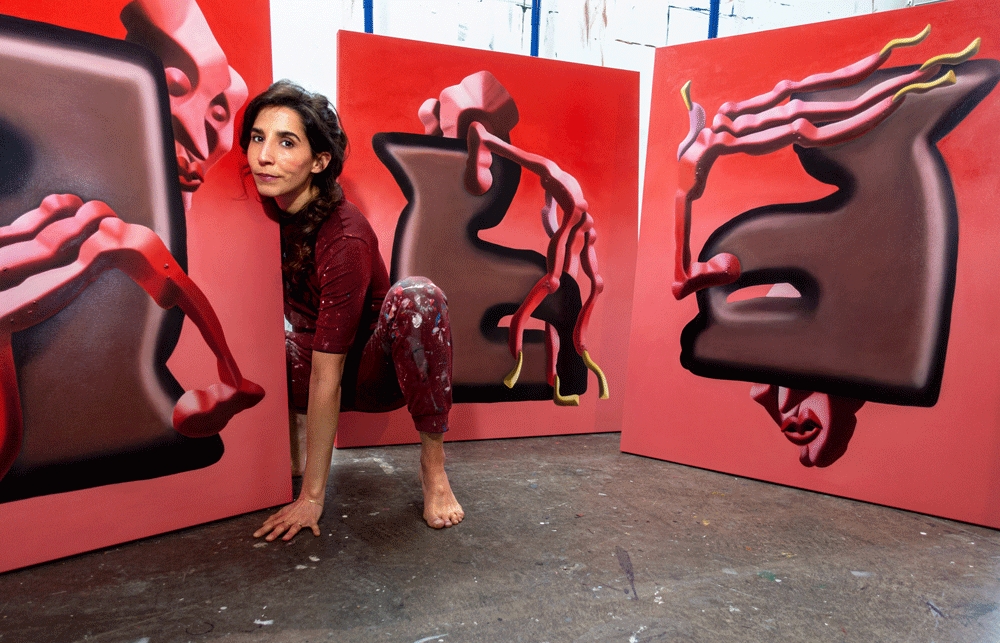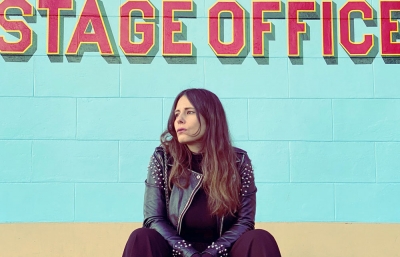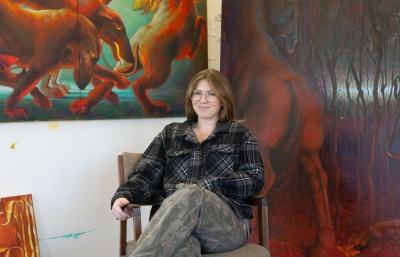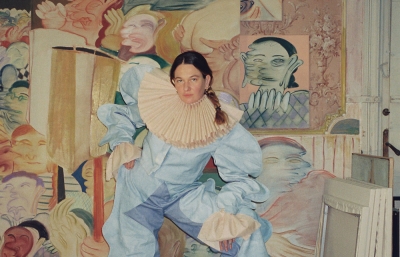Cathrin Hoffmann
The Big Why
Interview by Sasha Bogojev // Portrait by the artist
It’s always energizing to see resilient folks transform an indifferent experience into fuel that blazes a new path. Years of working in the advertising industry was like skating on the surface, pushing Cathrin Hoffman into a passion for making work that speaks about the human experience.
Through imagery and sculptural work depicting the sting and heat of being human, she delves into questions similar to those the European existentialist philosophers pondered over a hundred years ago. Blasting through an advanced digital age where reality and cyber existence keep shapeshifting, she creates rough 3D renderings of anthropomorphic shapes existing in desolate, void spaces. Stripped of identifying features, removed from objects that would suggest social status, they are portrayed with an emphasis of the questionable flaws we all carry. After years of photoshopping and perfecting models and consumer goods integral to her profession, Hoffmann decided to focus on telling the other, more complex, but certainly more emotional side of the human story.

Sasha Bogojev: Describe your metamorphosis from digital to analog.
Cathrin Hoffmann: I was traveling with my boyfriend, and we were in Leon, Nicaragua, where we rented a room in a shared house, and there was an actual table and a chair in the room for the first time during our trip. I had brought with me my graphic tablet and started drawing digitally for the first time. It was such a feeling of freedom not to have a purpose, not to have a briefing by an agency or by a client, just to think about the three months we had already traveled and drawing what we experienced. That was the first time I did that for, like, 12 hours a day. My boyfriend was going to the beach, and I sat there, drank rum, and drew.
Did you jump to oil on canvas right after you got back home?
No, I was afraid of the paint and the brush. But I decided to be more physical, trying to not only sit in front of the computer. I wanted to try something with real materials, so I started doing collages as well. It's cutting out and gluing and then a little bit of paint. But most of the time, I drew. I drew with pastel chalks, and that was okay. I wasn't afraid of those [laughs]. I had some really nice paintings that I made digitally, and I thought that I really wanted to see them on a big scale. So I decided to paint them and sneak in the canvas.
I guess a more standard trajectory is to learn techniques and develop what you want to paint alongside. Was it frustrating trying to manifest your finished digital work with a different technique?
Yeah, it was terrible. Starting out, I really thought I needed to have lessons, that I needed to go to school somehow because I wouldn’t be able to learn otherwise. I realized painting is too hard. So I watched a lot of YouTube videos but that didn't help, and I had always wanted to do it correctly. Maybe that's the German part of me—I wanted to do it like a "real painter" would. I thought I had to hold my brush like Picasso. I couldn't do it, and I still can't [laughs].
But now I know—fuck that! Do it however you want to do it. And this is where I come back to the first thing I said—I'm happy that I didn't have lessons because I think someone else would try to push me in a direction I would not go myself. And so I learned my own way, and I'm really happy that I learned it on my own and maybe have a different look than an educated painter.
Perhaps people would say, ''Well, you could achieve that easily.'' But I don't care, I like that. I do a lot of things differently. I realized people would say, ''Wow, that looks very weird.'' But it works. So, in the end, that's all I need. It works and I'm happy. So now, after two years of painting, it's really easy now. Sometimes I actually do find myself holding a brush like Picasso and it's like I'm almost there.

And what about achieving that end result that you set for yourself digitally?
That also changed because I realized it's not important to achieve that digital painting. It's not necessary. I actually gained confidence, and with being more confident, it's not important to make a copy of your reference. It's more important to convey this feeling and what I wanted to say in the painting. Not how it's blended, not how the gradient is. For me, at least, I don't care anymore about that stuff. That is also something I had to learn.
Failure is a very important part of the learning process. Going in the wrong directions, making mistakes, but accepting them and adapting.
Yeah, and to figure out what is important to you. Obviously I don’t have great technical skills but I also don't care a lot. It's only important on a specific level. Being well skilled doesn't add emotion to a painting—for me, at least. I realized that a bad brush stroke can create more feelings than a perfectly blended stroke or whatever. But I had to learn that. This perfection I used to have before always led me to a different direction and I lost track because of that. I used to think it was important to make a perfectly crafted painting. This was an ambivalence and a conflict. It was always like being on a battlefield with myself.
That’s probably because you're coming from the perfect world where software allows you to go way beyond human possibilities. It sounds like you now feel comfortable and confident with your technique?
I feel better [laughs].

And how does it feel now when you see your work? Having more confidence, was there a change from the first shows and how you feel nowadays?
Yeah, because I got to know a lot of the artists and I realized they are just people, and this is so good. Especially in observing their paintings, coming closer, driven by the graphic designer in me, just to find mistakes or just to observe the technique. And realizing it still doesn't matter, because the emotion you had when you first saw the painting had nothing to do with the technique. So why would you care now? So learning that from other paintings by other artists, was very helpful. That and being able to talk about it all helped me realize what's important to me in my work.
At what point did your imagery connect with the concept of identities lost through our online lives? Was that the concept that started everything?
So, there was no concept really, but now, since I have been talking more about my art, I realize I am always driven by the idea of humanity in general, actually. What is humanity about? How did we become what we are? And how are we at this point? What is important to us in terms of society? How is technology changing society? Does it change real humans? Does it change us, or are we still thinking of the same things that philosophers from the past wondered about? When I start drawing, it is very intuitive, but I think it has always been driven by the big question, Why? Though it's hard to really know.
What is your motivation for creating shapes that obscure the human and artificial, like using holes in the heads instead of eyes?
It depends. Sometimes, I think it's not important to give them eyes. It's funny because, when I start drawing or sketching, I do a lot of variants. So you might know one painting, but you don't know the many variants I did before that. Sometimes these variants have eyes, sometimes no eyes. I try to create a specific feeling, which I can't really identify. When I don't react to my own painting, when I don't have a feeling about it, when it's like, “Ah,” for me, then I have to go on and work on it. Sometimes the eyes won't help, sometimes the eyes distract, I think. For example, when an eye is looking in a direction, that means something. When the painting looks at your own eyes, that has a meaning. And sometimes I don't want that layer of meaning, I want something else. This is when I avoid giving them eyes.

"When the painting looks at your own eyes, that has a meaning."
When you mentioned Ren & Stimpy, I got curious about other artistic influences.
I loved Looney Tunes as well.
So, Ren & Stimpy, Looney Tunes, and Picasso’s way of holding a brush?
Yeah, only that. The paintings are “Ah.” [laughs]
Was the work of any particular artist groundbreaking or influential for you at any point?
It was Egon Schiele, definitely. When I’m in front of one of his paintings, it never loses me. So the moment I want to achieve is being hit by a painting. He's beating me up all the time. The same goes for Francis Bacon, who I think is a big influence. And so are a lot of German painters. It's a shame that I only know the males actually. Louise Bourgeois is one of the female painters I enjoy. But, in the past, when I started being interested in art and even during art lessons in school, we never talked about female artists. We all know that problem. So I always talk about male artists, but this is how I started, so I guess that’s that. I also like George Grosz a lot.
Do you recognize any element of German art movements or characteristics in your work?
It's hard to say, I don't know. Maybe the grumpy part. And also you could say a little bit of melancholy. I like this sadness in German paintings, the melancholy, and this post-war trauma. This is definitely what I'm attracted to. It actually comes back to emotional language again, which is a very strong element because of the war.

Your social media accounts show a keen interest in what's happening in Germany, especially the growth of right wing political views and, let's say, conservative ways of thinking. It's happening everywhere in the world, but obviously you're focused on where you live. Is this something that you would incorporate in your work, or are you already doing that in a way that I'm missing?
Well, I am German, but you see my face and I don't look German, right? I think it comes from a personal reality I had. I grew up in a very small town and I did not have very bad racist things happen to me, but a lot of little things constantly. I was always the not-German girl in class because I was the only one with black hair. So I dyed my hair a little bit lighter, I don't know if you can see that. And this is what I really don't like. My dad is German, he's blond, and he is very left wing, I would say. My mom is from Iran, and so I grew up always being in conflict between German and the Persian cultures and being perceived differently. That hurt me, of course, because racism sucks. And now to see our society growing more and more in that direction is very painful for me personally. I would say I'm not really a political person in terms of knowing all about what’s going on in politics. Maybe I'm not very well-informed sometimes, but I have a very strong urge to do something. I go to demonstrations a lot. I go to the streets. I try to do the little things, and yes, racism is a big thing for me personally, as well.
Do you think your mixed cultural background impels you, even subconsciously, to work with figures that don’t fit in any existing gender or racial boxes?
Actually, I think you're right. It's not the main thing I have in my mind, but now that you have said it out loud, I would agree. So, yes, it's not like this is my concept and I do it, but I have a very strong feeling to speak up. It's not only because of my heritage but also, I have a mentally disabled twin brother, so he is “different” as well. And I was always fighting for him, to show everyone that he is not different. So I have a big goal to try and be inclusive. I struggle to not see differences, but I do see them, of course. We are all a bit different. This is a human thing. I can also be very judgmental, too quickly sometimes, and I hate that as well.
In the midst of the 2020 madness, you managed to squeeze in a London solo show. Can you tell me about that?
When I started working on that show and I thought about the concept behind it, I came across a quote from the Danish philosopher Søren Kierkegaard that I knew of for a long time. He was questioning the world, basically: the big “Why?” that I was talking about before. The questions like, Why are we here? Why am I here? What is it all about? “I stick my finger in existence —it smells of nothing.” That is a part of the original quote, and I liked it so much. I was already carrying this quote around for a while, and I remembered it while I was working on the London show. During this isolation and the pandemic, this quote felt even more relevant. Because I was like, “You know what? When I stick my finger in existence right now, it still smells of nothing.” And we are hundreds of years apart from when he originally said that. This is a very short, compressed form of that story because it took a while until I came to that point. One of the paintings is actually titled I Stick My Finger in Existence.

And I'm sure that a lot of people connected it with Nirvana's album.
No, no one. Isn't it strange? No one. People were asking me if this is about Covid-19 and the loss of smell and taste. But, actually, no, I was not aware of those symptoms back then, so actually it's a coincidence.
Why did you decide to work with sculpture for that show? I mean, your work always felt like a painting of a sculpture, but it was still amazing to see them, and done so well too.
It was actually one of the first things I created for the show. And I was not sure if I wanted to put them in the show because I was not sure if they were good enough. Again, that perfection thing. I thought, “Well, yes, you enjoy it, why not?”
Do you make them by yourself?
Yeah. I don't have anyone here who could help me. I would love to have someone, but I have to do that all on my own. I always liked crafting and physical work. When I was young, I built tree houses on my own and things like that. I built a rabbit cage on my own, poor rabbit. It was like a haunted rabbit house. So I felt like I could do a sculpture because I love working with my hands anyway, even more than doing these very delicate parts. I like this rough stuff more, actually, using a hammer and wood, things like that.
Are they part of your plans for the future?
My plan for the coming future is actually doing more sculptures. I don't want to give up painting, but I would love to experiment more with sculpting. I think it is because I never felt like a real painter. I didn't really care about the medium at all, but I realized what a sculpture does to me as someone that sees it, that it’s as important to me as what the painting does.






